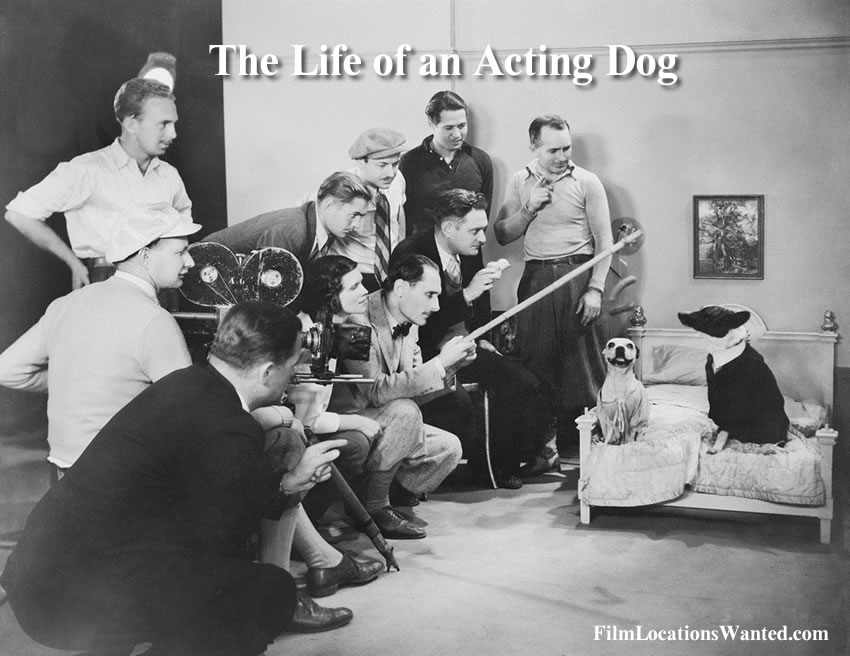The Life of an Acting Dog
Ever thought of calling your new dog Rover? Probably not, but there’s a reason why people reach for that name as stereotypically canine, and there was a time when Rover boomed as a popular dog name. In 1905, British director Cecil Hepworth released a silent film called Rescued by Rover starring, you guessed it, his family dog (who was really named Blair). Ever since, dogs have been upstaging their human counterparts and have become a mainstay of feature films and TV. In fact, a cottage industry has been built around canine stars, including trainers, agents, a version of the Oscars called the Pawscars, and even book deals, such as the recently released Citizen Canine: Dogs in Movies by Wendy Mitchell.
There was a time, in fact, when dogs vied with their human co-stars. Terry the dog, who is better known as Toto from Wizard of Oz, was paid $125 per week for his work. While Judy Garland received substantially more at $500 per week, Toto outdid other cast members, such as the Munchkins, who only earned $50 per week. In comparison, today’s canine star takes home a much more modest rate. Eddie from the hit series Frazier received only $10,000 per episode while Kelsey Grammar netted a whopping $1.6 million for each installment.
But then Toto had it rough (ugh!). During the filming of Wizard of Oz, the pup had to take a two-week hiatus after suffering a sprained foot when one of the Wicked Witch’s guardsmen stepped on it. It wasn’t until 1939 (four years later) that a horse who died on set during the filming of a stunt for a Jesse James flick led to the creation of American Humane Association (AHA) film guidelines for animal safety and protection–you know, “No animals were harmed in the making of this motion picture.” But don’t worry too much about Toto. Rumor has it he spent some of his recovery time at Garland’s house–poor pooch!
So what is life like for all those wonderful diva dogs? Well, first of all, you might be surprised to know that sometimes it’s not one diva you’re watching. In the 2015 film Max, the titular canine star was actually five dogs. Carlos the dog was used for closeups, but stunt doubles (?) were used for specialties, such as baring teeth, running and jumping, and so forth. It might also surprise you, considering their cuddly cuteness, that dogs onset do lead a somewhat diva existence that has less to do with attitude and more to do with protection from overstimulation. AHA guidelines require that “production shall limit cast and crew in areas where puppies are being used” and “production and the animal handler shall limit the handling, petting and touching of puppies to only necessary individuals.” Puppies, like in any other situation, receive special dispensations on set.
But just like any other star, dogs come with their own set of expectations and obligations. Canines must have required vaccinations and health certificates and are expected at a minimum to have strong off-leash obedience. In fact, many agencies recommend potential pawlets first pass the Canine Good Citizens test (known as the CGC). Then come all the specific film expectations of onscreen conduct that require in-depth training.
Teresa Ann Miller, who is the daughter of famous animal trainer Karl Lewis Miller, was responsible, in part, for the animal actions of one of the finest animal films ever made, Babe. Babe involved “970 trained animals, 57 animal handlers, 18 months of animal training, six months of filming and 12 months of post-production.” It also grossed $250 million at the box office and received 7 Oscar nominations. While Teresa was mostly responsible for pig training in the film, she has much to offer concerning dogs as well. Puppies, for example, she says, are “like sponges” in the way they absorb training, but have less capacity for complicated scenes. She also notes that one of the hardest things for a dog to do on set is nothing. As she puts it, “they’re looking for a reason why they’re there, what they should be doing.”
She also offers a few tricks of the trade, such as the clicker, which she and other trainers use as a conditioned response to get the dog’s attention and to get them to act. She also reveals the feedstick, which has a bright green ball on the end for the dog to focus on. Ever wonder how they get a dog to look exactly where they need to? Somewhere off camera is that bright green ball they’re looking at.
So let’s hear it for our furry feature actors! From Cujo to Rin Tin Tin, we all have a favorite. And just think, MGM initially considered putting a man in a dog suit to play Toto. Where would we be now if not for that spunky little terrier and all the dog stars that were to follow?
—Ivan Young is a writer from Happy Writers, Co. in partnership with dog hip harness manufacturer, Walkin’ Pets.




